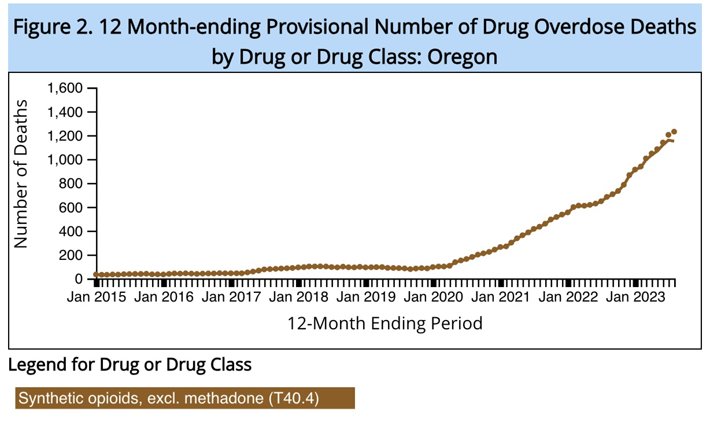Oregon’s Drug Decriminalization Law Fails to Save Lives

In November 2020, 58% of voters in Oregon approved Measure 110, a new ballot initiative that decriminalized “personal quantities” of drugs. Supporters championed Measure 110 as a revolutionary approach that would transform addiction by minimizing penalties for drug use while redirecting funds toward expanded recovery services.
What is a personal quantity of drugs?
- Less than 1 gram of heroin
- Less than 1 gram or fewer than 5 pills of MDMA
- Less than 2 grams of methamphetamine or cocaine
- Fewer than 40 units of LSD
- Less than 12 grams of psilocybin
- Fewer than 40 units of methadone
- Fewer than 40 pills of oxycodone
The idea behind the new law was to stop arresting people for using drugs and instead help them find the services that could enable them to stop. Under this law, a person found with these personal quantities of drugs would be charged with a minor violation accompanied by a $100 fine. It would be more or less the equivalent of a traffic violation.
The $100 fine could be waived if the person called a Behavioral Health hotline to be screened for addiction within 45 days of receiving the citation. The idea was that those contacting this hotline would be encouraged to accept drug rehabilitation services.
However, part of the law states that if the fine is not paid, it “is not a basis for further penalties or for a term of incarceration.” So essentially, there’s no penalty if a person is found with a personal quantity of illicit drugs. All they have to do is ignore the citation and not call the hotline. Even if they do call the hotline, there’s no obligation to accept the offer of treatment.
The state’s cannabis tax revenue was expected to pay for the addiction treatment services offered to those being cited.
Is the New Law Working?

Possibly, the law could be considered successful if certain reasonable criteria were met that proved that more individuals were becoming drug-free. Perhaps these criteria would show that kind of improvement:
- The number of people cited for possessing drugs who then ask for help.
- Less crime and less drug use in the cities.
- A gradual reduction in drug deaths.
If these three results showed up, then most Oregonians and, indeed, most people everywhere would probably agree that the law was working.
So, is Oregon seeing these three results?
- Do the people who get citations ask for help? Between the enactment of the law on February 1, 2021, and December 31, 2023, more than 7,349 citations were issued for drug possession. However, fewer than 600 people called the hotline within the first three years to get an addiction screening. Only 1% of those who received the citations asked for help during the screening process.
- Have there been less crime and less drug use? An April 2023 survey revealed that 63% of Oregonians believe that Measure 110 made crime worse, while 7% thought it improved crime statistics, 20% thought there was no impact, and 10% didn’t know. In the same survey, 65% of respondents thought that the measure made drug addiction and drug abuse worse. Not surprisingly, 63% of Oregonians also supported the return of criminal penalties for drug possession, while also continuing to fund drug treatment programs. Oregon cities also suffer from open-air drug use, or drug use out in the open. This has been part of what has caused the recent backlash from Oregonians and proposals to reinstate criminal penalties for drug possession. In 2023, Portland Mayor Ted Wheeler stated, “The last time I saw somebody consuming what I believe to be fentanyl publicly on our streets was less than five minutes ago, three blocks from City Hall.” Portland’s Commissioner of Public Safety Rene Gonzales appeared on Oregon Public Broadcasting’s “Think Out Loud” and said: “I would also submit that we’ve taken a number of steps in recent years including Measure 110 to destigmatize public drug use. And we were promised if we destigmatize that, that would lead to better health outcomes. We’re not seeing those better outcomes.”
- Has there been a reduction in drug deaths? Reporting by Associated Press provides evidence that there has not been a reduction in either drug use or drug deaths: “Oregon’s first-in-the-nation law that decriminalized the possession of small amounts of heroin, cocaine, and other illicit drugs in favor of an emphasis on addiction treatment is facing strong headwinds in the progressive state after an explosion of public drug use fueled by the proliferation of fentanyl and a surge in deaths from opioids, including those of children.”
Fentanyl Seriously Complicates This Situation
The decriminalization of “personal qualities” of illicit drugs (which took effect in February 2021) included fentanyl. However, Oregon has suffered greatly from a growing influx of illicitly manufactured fentanyl, the powerful synthetic opioid that has all but replaced heroin and prescription drugs on the illicit market.
According to the Drug Enforcement Administration, the trafficking of illicit fentanyl into the U.S. began in 2014. By 2019, this criminal industry had ramped up and diversified, with the drug in powder form being sold on the street, along with fentanyl getting mixed into heroin, cocaine, and methamphetamine and also being pressed into counterfeit pills.
In the following graph, you get a vivid picture of what has happened in Oregon. This graph from the Centers for Disease Control and Prevention shows the number of fentanyl deaths for each twelve-month ending period starting January 2015 and ending in August 2023.

The following figures taken from the CDC’s National Vital Statistics System further illustrate the devastation sweeping across the state.
Fentanyl deaths, cumulative, in the prior twelve-month period:
- January 2015: 33
- January 2017: 43
- January 2020: 95
- January 2021: 263
- February 2021: 268 (the month the law went into effect)
- January 2023: 912
- August 2023: 1,129 (most recent data available at the time this article was written)
Statistics collected from the National Vital Statistics System, Provisional Drug Overdose Death Counts from the Centers for Disease Control and Prevention.
Between January 2015 and August 2023, illicit fentanyl deaths in Oregon increased 3,421%.
The vast growth in seizures of fentanyl by law enforcement personnel may further explain why the timing for Measure 110 didn’t work out so well. According to Oregon Public Broadcasting, a federal drug task force operating in Oregon and Idaho seized 27 doses of fentanyl in 2018. In 2022, they seized more than 32 million doses. That is an increase of 118,000,000 percent.
Intense Impact on Ethnic Minorities
The recent impact of drug abuse and addiction on American Indians, Alaska Natives, and Black or African American Oregonians has been far more brutal than the impact on the general population.
Revealing this impact is the rate of drug overdose deaths per 100,000 of each particular population.
- Overdose deaths among American Indian or Alaska Native Oregonians increased from 46.6 per 100,000 population in 2021 to 85 per 100,000 in 2022.
- Overdose deaths related to overdose for Black or African American Oregonians increased from 33.6 deaths per 100,000 population in 2018 to 78.3 per 100,000 in 2022.
The State Begins to Implement Changes to Turn Things Around

In 2023, one action after another began to be taken by lawmakers to alleviate the problems that seemed to crop up after Measure 110 was implemented.
- In June 2023, state lawmakers passed a bill reducing the amount of fentanyl a person can possess without penalty. Prior to the passage of this bill, a person could possess five grams or about 25 pills that contained fentanyl and not be arrested. (For a person unaccustomed to using opioids, two milligrams is all it takes to fatally overdose.) The new guideline setting the legal limit at one gram or five pills was signed by the governor of Oregon on July 27, 2023.
- In September 2023, Portland city officials approved a ban on public drug use.
- In November 2023, a group of state representatives sent a letter to Governor Tina Kotek, requesting that she call a special session to address the issue before the Legislature reconvenes in February.
- In December 2023, state officials replaced the old contractor taking calls on the state’s addiction screening hotline with a new contractor.
The November 2023 letter from Oregon representatives to Governor Kotek stated:
“Senate Republicans are asking you to declare a state of emergency on Measure 110. We also join Representative Reschke and Senator Brock Smith in asking you to convene a special session to immediately address Oregon’s drug addiction crisis…. Oregon voters feel that Measure 110 has made addiction, homelessness, and crime worse…. Oregonians want implemented solutions, not ‘too little, too late’ discussions in an interim committee. Families deserve to feel safe in their communities and every Oregonian deserves to live a life free of addiction.”
Oregon’s Struggle to Strike the Right Balance
Oregon has served as a test case for the decriminalization of addictive substances. According to Oregon’s own population, it does not seem to be a successful experiment. It’s hard for individuals on either side of this issue to know how to reduce punitive actions without triggering increased drug use and related crime. It’s never easy to convince an addicted person to accept help. That has long been true when a family tries to help one of their own, and it’s just as true when you are trying to address a drug problem across an entire state.
Obviously, the situation in Oregon is complicated and contains many more factors than those included in this article. Understanding all these factors requires many hours of study. It is hoped that this introduction to the subject helps you start to feel informed about the problems surrounding Measure 110.
Those who are addicted must be treated with compassion. When recovery is possible without incarceration, a sober, healthy person can be returned to society without the emotional and financial trauma that being incarcerated causes. Ample access to effective drug rehabilitation services will always be an essential part of solving this problem and must be emphasized.
Sources:
- “Oregon’s Drug Decriminalization Law Faces Growing Pushback Amid Fentanyl Crisis.” Voice of America News, 2023. VOA
- “Class E Violation Proceedings.” Oregon Laws, undated. Oregon Laws
- “Oregon Judicial Department, Measure 110.” Oregon Judicial Department, 2024. Oregon Judicial Department
- “Oregon’s First-in-the-Nation Drug Decriminalization Law is Facing Pushback Amid the Fentanyl Crisis.” Associated Press, 2023. AP
- “Measure 110 Oregon Voter Survey.” DHM Research, 2023. DHM Research
- “Drug Decriminalization Stumbled in Oregon. Other States Are Taking Note.” Oregon Capital Chronicle, 2023. OCC
- “Portland City Commissioner Rene Gonzalez on Public Safety Issues.” Oregon Public Broadcasting, 2023. OPB
- “Fentanyl Flow to the United States.” Drug Enforcement Administration, 2020. DEA
- “National Vital Statistics System, Provisional Drug Overdose Death Counts.” Centers for Disease Control and Prevention, 2024. CDC
- “Measure 110 Forced Oregon to Build a New Drug Addiction Services Model. Here’s How That’s Going.” Oregon Public Broadcasting, 2023. OPB
- “Recommendations for Immediate Action to Reduce the Number of People Who Die of Overdose in Oregon.” Oregon Alcohol and Drug Policy Commission, 2023. OADPC
- “Oregon Health Officials Promise to Revamp Measure 110 Hotline with New Contractor.” Oregon Public Broadcasting, 2023. OPB


 ®
®